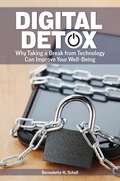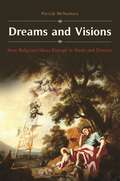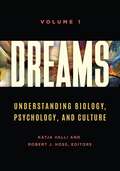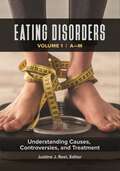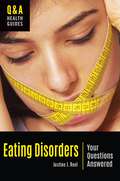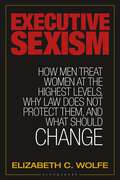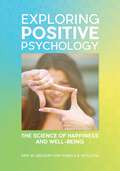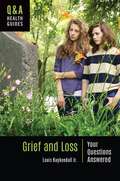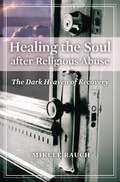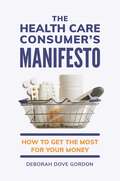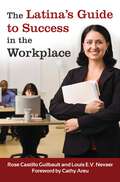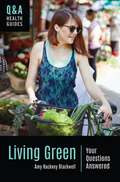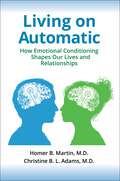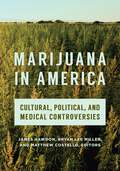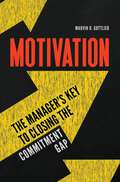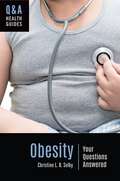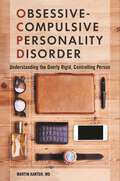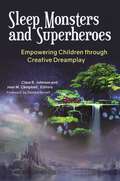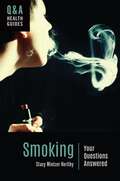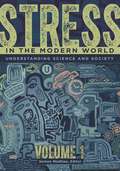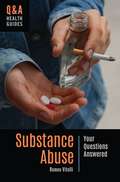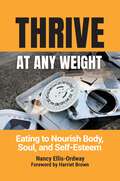- Table View
- List View
Digital Detox: Why Taking a Break from Technology Can Improve Your Well-Being
by Bernadette H. SchellThis book discusses the dangers of too much technology use, explores the benefits of digital detoxing, and outlines the different programs and approaches available to help you unplug. It's an invaluable resource for readers looking to establish a healthier relationship with the digital world.Health professionals and the general public are becoming increasingly aware that addiction to the internet, social media, online games, and other forms of technology has become a real problem with significant negative impacts on physical, psychological, and social health. To combat this issue, some are now undertaking a "digital detox," and many options have emerged to help individuals unplug, whether for a weekend or for longer-term change.Digital Detox: Why Taking a Break from Technology Can Improve Your Well-Being explores both the dark side of technology's ever-present existence in today's world and what individuals can do to find better balance in their digital lives. Part I explores addiction to the internet and other novel technologies. What effect does overindulgence in social media, gaming, online shopping, or even "doomscrolling" through internet news sites have on our self-esteem, relationships with others, and happiness? This section also explores how researchers study and quantify technology addiction. Part II focuses on the digital detox countermovement, examining how various programs, support groups, retreats, and even technology itself can help individuals conquer their digital addictions.
Dreams and Visions: How Religious Ideas Emerge in Sleep and Dreams (Brain, Behavior, and Evolution)
by Patrick McNamara Ph.D.A standout resource on the emerging field of applying neuropsychology and the latest findings in sleep and dream research to religious experience, this book investigates the proven biological links between REM dreams and religious ideas, covering past and current schools of thought in both the science of dreams and the science of religion.Across time and around the world, billions of people with highly dissimilar backgrounds and cultures have felt spiritual or religious inspiration that shaped their lives and supplemented their mental strength—and in many cases, this inspiration came via a dream. The "how" and "why" of this common phenomenon is one that science has largely failed to explain. In this book, nationally recognized behavioral neuroscientist Patrick McNamara taps the latest science in sleep and dreams as well as neuropsychology to investigate one facet of the answer from the "inside out"—the human brain's role.The first study of its kind in an emerging field, Dreams and Visions: How Religious Ideas Emerge in Sleep and Dreams provides a comprehensive summary of past theory and examines the latest science on dreams, REM sleep, cognitive approaches to religion, and neuroscience approaches to religion. Readers will come away with an in-depth understanding of how and why god beliefs and spiritual convictions so often emerge in our dreams. Dedicated sections address special dream types like visitation dreams, nightmares, precognitive dreams, "big" dreams, lucid dreams, paralysis dreams, twin dreams, and more.
Dreams [2 volumes]: Understanding Biology, Psychology, and Culture [2 volumes]
by Katja Valli, Robert J. Hoss and Robert P. GongloffThis two-volume set examines dreams and dreaming from a variety of angles—biological, psychological, and sociocultural—in order to provide readers with a holistic introduction to this fascinating subject.Whether good or bad and whether we remember them or not, each night every one of us dreams. But what biological or psychological function do dreams serve? What do these vivid images and strange storylines mean? How have psychologists, religions, and society at large interpreted dreams, and how can a closer examination of our dreams provide useful insights?Dreams: Understanding Biology, Psychology, and Culture presents a holistic view of dreams and the dreaming experience that answers these and many other questions. Divided thematically, this two-volume book examines the complex and often misunderstood subject of dreaming through a variety of lenses. This collection is written by a large and diverse team of experts and edited by leading members of the International Association for the Study of Dreams (IASD) but remains an approachable and accessible introduction to this captivating topic for all readers.
Eating Disorders [2 volumes]: Understanding Causes, Controversies, and Treatment [2 volumes]
by Justine J. ReelThis encyclopedia offers a variety of resources for readers interested in learning more about eating disorders, including hundreds of reference entries, interviews, scholarly debates, and case studies.While many people may reflexively imagine an anorexic or bulimia teenage girl upon being asked to think about eating disorders, eating disorders are a form of mental illness that can take many forms and affect individuals of all genders, ages, and ethnic backgrounds. In fact, an estimated eight million people in the United States struggle with an eating disorder, making eating disorders one of the most prevalent forms of mental illness in America. This two-volume encyclopedia comprehensively examines eating disorders as the forms they can take; their causes and potential complications; and how they can best be treated and prevented. It also examines the influence had by cultural factors such as the fashion industry, television and movies, and social media. More than just a simple A-to-Z reference, Eating Disorders: Understanding Causes, Controversies, and Treatment also includes valuable features such as Q&A interviews with those affected by and working to combat eating disorders, case studies, scholarly essays that voice opinions in key debates, and a directory of resources for individuals seeking help.
Eating Disorders: Your Questions Answered (Q&A Health Guides)
by Justine J. ReelThis book is an approachable introduction to eating disorders; one of the most common—and dangerous—forms of mental illness. The information, guidance, and resources offered make it a valuable tool for anyone struggling with issues surrounding food, weight, and body image.In the United States today, an estimated 20 million women and 10 million men meet the diagnostic criteria for an eating disorder, and millions more have disordered eating habits and a dysfunctional relationship with food. Whether their disorder is diagnosed or not, individuals struggling with these issues face serious and potentially lifelong physical and emotional consequences as a result of their behaviors. Eating Disorders: Your Questions Answered, a part of Greenwood's Q&A Health Guides series, provides clear, concise information for readers who want to learn more about these often misunderstood psychiatric illnesses. In addition to discussing the most common eating disorders, their consequences, and treatment, this book also explores how eating disorders develop and how they can be prevented.Each book in this series follows a reader-friendly question-and-answer format that anticipates readers' needs and concerns. Prevalent myths and misconceptions are identified and dispelled, and a collection of case studies illustrates key concepts and issues through relatable stories and insightful recommendations. The book also includes a section on health literacy, equipping teens and young adults with practical tools and strategies for finding, evaluating, and using credible sources of health information both on and off the internet—important skills that contribute to a lifetime of healthy decision-making.
Executive Sexism: How Men Treat Women at the Highest Levels, Why Law Does Not Protect Them, and What Should Change
by Elizabeth C. WolfeIn the long shadow of a presidential election rife with charges of sexist actions, this book explains how very common such behavior is among executives, why law doesn't protect victims, and how female professionals can bring change.Who do you report sexism to when the offender owns the company?"Overt and intentional sexism" against women by powerful men in politics, business, and academia and across the white-collar world in public and private institutions is common, according to author Elizabeth C. Wolfe, a conflict analysis and resolution specialist. Female executives, even at the pinnacle of their careers, remain vulnerable to their male colleagues. In this book, Wolfe details how men treat women at the highest levels and the result of their actions.Women executives from nine countries explain how their career advancement and earning potential are continuously harmed though overt sexism, sexist social behavior, and microaggressions--those damaging behaviors that are in a gray area but are not legally actionable. She further examines why law does not protect these women: sexism, like racism, is a way of thinking and so cannot be legislated. Each "-ism" has legal protections against documentable actions, but ways of thinking, socializing rituals, and microaggressions are not actionable by law. Wolfe details the minds of sexists and describes how sexism is "socialized," and then explains how to name each sexist behavior, address it, and take action to stop it.
Exploring Positive Psychology: The Science of Happiness and Well-Being
by Erik M. Gregory Pamela B. RutledgeLooking for an introduction to positive psychology that offers real-life examples? This overview of the science of happiness supplies case studies from some of the world's most successful organizations and describes ways to experience the personal impact of this exciting scientific field.Rather than focusing on treating what is "wrong" with a person, positive psychology seeks to understand and foster the things that drive happiness, creativity, and emotional fulfillment. This is a relatively new area of psychological study, and this reference book presents the research and practice of positive psychology in an informative and accessible format. Readers are given a history of the field, its current applications, and the future implications of this psychological discipline. Case studies from companies such as The Body Shop, Volvo, Zappos, and Google highlight the impact of positive psychology when it's applied in a modern business setting. These case studies, along with biographies of leaders in the field, highlight each chapter and connect the dots between the empirical theory of positive psychology and its practice. Readers also receive tools to apply the practices to their own lives.
Grief and Loss: Your Questions Answered (Q&A Health Guides)
by Louis Kuykendall Jr.Although aimed primarily at teens and young adults, who may be experiencing a significant loss for the first time, the information, guidance, and resources this book offers make it a valuable tool for anyone directly or indirectly affected by grief.Although a near-universal experience, grief can be very difficult to talk about and handle. Many of the thoughts and emotions that arise during grief are powerful and can be isolating, confusing, and overwhelming. Teens often struggle with loss and may feel alone, betrayed, or guilty. If left unsupported, bereaved adolescents and young adults can develop emotional and behavioral problems or depression, or even become suicidal. Dealing with grief in healthy ways is critical to accepting and adapting to the loss and the changes loss brings.Books in Greenwood's Q&A Health Guides series follow a reader-friendly question-and-answer format that anticipates readers' needs and concerns. Prevalent myths and misconceptions are identified and dispelled, and a collection of case studies illustrates key concepts and issues through relatable stories and insightful recommendations. Each book also includes a section on health literacy, equipping teens and young adults with practical tools and strategies for finding, evaluating, and using credible sources of health information both on and off the internet—important skills that contribute to a lifetime of healthy decision-making.
Healing the Soul after Religious Abuse: The Dark Heaven of Recovery (Religion, Health, and Healing)
by Mikele RauchRecent scandals of clergy sexual abuse have brought attention to the victims and their responses to and recovery from their abuse. But few have considered the effect of the abuse on a victim's soul and religious outlook and beliefs. Healing the Soul after Religious Abuse, offers a unique perspective of recovery and restoration of the soul after religious abuse. The author argues that religious abuse often stops not only psychological growth, but also inward development. The effect is not simply emotional, because the devastation reaches to the core of the spirit. Often there is no place for a God of love or a love of what once was divine. Through a series of personal interviews with persons from the five major religions, Rauch considers various ways that religion can do harm.The stories told in this book include the road to restoration in the wake of institutional abuse and how inner experience is sometimes confused with religious training; the sacred task of spiritual leadership and how to restore trust when there has been a violation; an exploration of sacrifice and a clarification of the notion of shame; a look at the impact of religious bigotry in the areas of race, sexuality, and tolerance; an overview of sexuality and the place it holds in both celibate and family life; the pernicious issue of clergy sexual abuse and the signs of spiritual trauma in response to such violation; a roadmap for restoration and a challenge to religious institutions; and, lastly, ways to reclaim the sacred and rewire the spirit. Through interviews, research, and personal stories, the author tells a story of recovery of the most delicate kind, offering pathways through the dark night of religious violation to a restoration of the soul and its immense possibilities.
The Health Care Consumer's Manifesto: How to Get the Most for Your Money
by Deborah Dove GordonA health care executive at Harvard explains how to become a savvy consumer and get the value we all deserve for our health care spending.This book navigates and demystifies the confusing world of health care shopping. Readers go on a guided tour inside American health care to learn why it is so messy, and who is invested in keeping it that way. The text offers a new vision of how health care could work if it were truly designed to meet consumer needs, creating a call to action on how to demand and help create such a system. A wake-up call to an industry tenuously holding on to the status quo and ripe for true disruption, this book outlines what consumers can do themselves and demand from doctors, hospitals, health plans, and policy makers to get more for their health care spending and, in so doing, reshape the health care system into one we all deserve. Using real and compelling consumer stories intertwined with expert analysis, this book illustrates why it is so difficult to act as an engaged health care consumer in the United States and pulls back the curtain to expose the forces that hold the system in place.
The Latina's Guide to Success in the Workplace
by Rose Castillo Guilbault Louis E.V. NevaerThis hands-on manual provides Latinas with the tools they need to succeed at work by examining some of the societal and cultural obstacles that hinder their progress.Despite being 20 million strong, Latinas represent America's most undervalued human resource. This career guide is the only one of its kind to focus specifically on empowering the working women of the Latina community to embrace success and build skills for workplace advancement.The Latina's Guide to Success in the Workplace explores the complexity of the Hispanic/Latino identity and the impact of this culture on professional mobility. The author asserts that there are five obstacles which Latinas confront within their own belief system: the idea that women do not need an education; the assumption that the needs of men come first; a belief that it is sinful to desire money; the opinion that Latinas should not be ambitious; and the mindset that successful women in the United States lose their femininity. Throughout the book, up-to-date research, case studies, and inspirational interviews offer strategies for overcoming the cultural factors that limit Latinas and providing a roadmap for achieving success.
Living Green: Your Questions Answered (Q&A Health Guides)
by Amy Hackney BlackwellThis book makes "green living," as it relates to teens and young adults, an approachable subject. The information and resources it comprises make it valuable for anyone who is interested in living a more sustainable and environmentally friendly life.Our actions have a powerful impact on the environment: how we heat and cool our homes, the types of cars we drive, and even the foods we consume all contribute to the health of the planet. Living Green: Your Questions Answered, an installment in Greenwood's Q&A Health Guides series, provides clear, concise answers to readers' questions about living a more eco-conscious life. In addition to explaining fundamental concepts such as carbon footprint, climate change, and sustainability, this book offers practical steps readers can take in their everyday lives to reduce their environmental impact across a number of areas, including energy usage, transportation, food and water, and even fashion and personal care products.Each book in this series follows a reader-friendly question-and-answer format that anticipates readers' needs and concerns. Prevalent myths and misconceptions are identified and dispelled, and a collection of case studies illustrates key concepts and issues through relatable stories and insightful recommendations. The book also includes a section on health literacy, equipping teens and young adults with practical tools and strategies for finding, evaluating, and using credible sources of health information both on and off the internet—important skills that contribute to a lifetime of healthy decision-making.
Living on Automatic: How Emotional Conditioning Shapes Our Lives and Relationships
by Homer B. MD Christine B. MDTwo veteran psychiatrists unravel the mystery of how thought and emotional patterns are passed from parents to children, generation after generation, "conditioning" each of us in ways that endure throughout our lives and affect all of our relationships.Living on Automatic not only introduces the concept of emotional conditioning, including how it occurs and becomes entrenched in our minds, but also explains how individuals can "decondition" themselves to become more adept at choosing and negotiating more rewarding relationships. Authored by two psychiatrists, the text draws from more than 80 years of their combined psychotherapy work with thousands of people. The authors focus on helping readers to understand their roles in relationships and to develop more rewarding relationships. Case studies and questions are provided to illustrate emotional conditioning and the personality roles that emerge from it. Readers will learn why people choose the mates that they do; why the ways we learn to relate as children often do not change later in life; and how to observe and engage in introspection to begin to decondition themselves from auto-pilot, knee-jerk emotional responses, allowing for the formation of better relationships with their spouse or partner, children, and other family members.
Marijuana in America: Cultural, Political, and Medical Controversies
by James Hawdon, Bryan Lee Miller, and Matthew CostelloThis A–Z encyclopedia provides a broad and evenhanded overview of America's complex relationship with marijuana, examining political, recreational, cultural, medical, and economic aspects of marijuana use both historically and in the present day.Marijuana in America is an accessible and comprehensive exploration of the many changes in medical, legal, and cultural issues surrounding cannabis in the United States. This multidisciplinary volume features contributions from several different fields to explain all facets of marijuana, including its chemical composition, evolving depictions in popular culture, and historical, legal, and social settings in which marijuana use occurs.A mix of coverage provides readers with a full and accurate understanding of the spectrum of issues and controversies swirling around marijuana today, including: the changing legal landscape pertaining to the sale, possession, and use of marijuana, both at the state and federal levels; the factual basis for arguments for and against so-called "medical marijuana"; claims that marijuana is a gateway drug to harder drugs; changing cultural attitudes about marijuana and "potheads"; economic arguments for and against marijuana legalization; and the impact of marijuana on families, communities, the economy, and the criminal justice system.
Motivation: The Manager's Key to Closing the Commitment Gap
by Marvin R. Ph.D.This book shows managers how to identify opportunities for increasing productivity by enhancing commitment and provides tools for building a high-performing team.More than ever, senior and frontline managers are tasked with the development and maintenance of highly productive teams—a formidable challenge in all situations. Organizational directives for "lean," highly responsive, change-adaptive workforces have created an environment in which every aspect of productivity must be examined and improved in the quest to meet increasingly competitive global goals. About 30 percent of productivity is lost from knowledge workers who withhold undetected discretionary effort because managers fail to tap into motivation dynamics that impact the level of individual and team commitment. This book gives managers the tools they need to motivate their teams to deliver significantly better results.Readers of Motivation: The Manager's Key to Closing the Commitment Gap will gain a foundational understanding of motivation from theoretical, experimental, and anecdotal perspectives and identify key areas of potential untapped productivity. The book explores the changing workforce values, economic pressures, and the revised compact between employers and employees that create the commitment gap that results in untapped productivity. Managers will see how to go through a diagnostic and relationship-building process that creates powerful and productive dialogues, resolves conflict, and pinpoints behaviors and identifies tools to build a fully committed, high-performing team.
Obesity: Your Questions Answered (Q&A Health Guides)
by Christine L. SelbyThis book serves as an accessible resource for teens who want to learn more about obesity. The information and guidance it offers make it a valuable tool for young adult readers with questions or concerns about their weight.Obesity—represented by a BMI over 30—may be easy to define, but its causes and consequences and how individuals and agencies should address it are not as clear. Is obesity simply the result of eating more calories than one burns, or are other factors involved? Can an individual be obese and healthy? How does obesity affect psychological and social health? Are public health campaigns targeted at reducing obesity helping or hurting? Obesity: Your Questions Answered, a part of Greenwood's Q&A Health Guides series, answers these and other questions related to this high-interest topic. Each book in this series follows a reader-friendly question-and-answer format that anticipates readers' needs and concerns. Prevalent myths and misconceptions are identified and dispelled, and a collection of case studies illustrates key concepts and issues through relatable stories and insightful recommendations. The book also includes a section on health literacy, equipping teens and young adults with practical tools and strategies for finding, evaluating, and using credible sources of health information both on and off the internet—important skills that contribute to a lifetime of healthy decision-making.
Obsessive-Compulsive Personality Disorder: Understanding the Overly Rigid, Controlling Person
by Martin Kantor MDThis unprecedented work is an invaluable resource for therapists treating patients with obsessive-compulsive personality disorder (OCPD), for individuals suffering from OCPD, and for friends, family, and coworkers of those with OCPD.Although a significant number of individuals suffer from obsessive-compulsive personality disorder (OCPD), most of these people see themselves as being perfectly normal. In actuality, they are missing out in life due to their being compulsively prompt, counterproductively perfectionistic, and excessively penurious. This book explains what OCPD is, making it clear how it differs significantly from OCD; explains the thought processes and desires that give rise to the counterproductive defense mechanisms of OCPD; and identifies the approaches and methods that can allow such afflicted individuals to break through their character armoring and become rehumanized.In this book, Martin Kantor, MD, presents information to defuse the many manifested symptoms of OCPD: anxiety, indecision, unreasonable perfectionism, and difficulty in compromising. His explanations and methods will give the hopeless succor, move the stalled forward, and foster interpersonal cooperation and flexibility in the stubborn, while simultaneously enhancing the OCPD individual's social performance thus increasing his or her chances for interpersonal, relational, and occupational success. Kantor also identifies the social manifestations of OCPD and describes how to move idiosyncratic, rigid bureaucracies toward accomplishing what should be their most important mission: helping those who are in need and seeking comfort.
Prescription Drug Abuse (Health and Medical Issues Today)
by Robert L. Bryant Howard L. MDThe misuse and abuse of prescription drugs has reached epidemic proportions in recent years, yet many individuals still believe, incorrectly, that their use is without risk. This book explores those risks as well as controversies surrounding this public health issue.Prescription drugs are powerful tools that can be used to treat a variety of ailments, from pain to anxiety to insomnia. Their potency and perceived safety also make them targets for abuse. The misuse of prescription drugs can have dire health consequences for individuals and high economic costs for society, among other dangers. A part of Greenwood's Health and Medical Issues Today series, this book identifies prescription drugs that are abused and the consequences such abuse can have for both individuals and society, and discusses the many questions relating to how to address this public health issue. Part I explores the current magnitude of the prescription drug abuse epidemic in the United States, which drugs are most frequently abused, how individuals obtain these medications, and the consequences of abuse. Part II delves into the controversies surrounding the topic, including the roles that doctors and "Big Pharma" play and legal issues regarding prosecution of prescription drug abusers. Part III provides a variety of useful materials, including case studies, a timeline of critical events, and a directory of resources.
Prescription Drug Abuse: A Reference Handbook (Contemporary World Issues)
by David E. NewtonThis outstanding resource guide for students and young adults provides an introduction to the history of prescription drug abuse that explains how this problem has arisen and examines the social, political, economic, and health issues associated with prescription drug abuse in modern society.Evidence suggests that both adults and youth are abusing a wider range of prescription drugs and abusing them more frequently than has been the case in the past. Prescription drugs are the second most common class of drugs abused by Americans, more than twice as commonly abused as cocaine, and five times as commonly abused as heroin. This book provides readers with information about the specific health effects that can result from using certain types of medical chemicals, particularly opioid analgesics, stimulants, depressants, and hallucinogenics; explains the most important factors that have led to the growth of prescription drug problems; and reviews the current status of the issue in the United States and other nations.Readers will learn about the dangers associated with the use of prescription drugs for nonmedical purposes, the methods that have been put in place and are being developed to prevent the abuse of prescription drugs, and the trends in prescription drug misuse, with possible explanations for these trends. The book also reviews some of the steps being taken by governments and other organizations and agencies to combat the problem of prescription drug abuse.
Sleep Monsters and Superheroes: Empowering Children through Creative Dreamplay
by Clare R. Johnson and Jean M. CampbellWorld-renowned contributors across several disciplines reveal how dreams can aid and empower children in daily life.Children can feel powerless in waking life, a fact that is often reflected in their dreams. This book shows how to take an active role in guiding children's dreams to help grow their confidence and improve their coping skills for real-life difficulties. Contributors from across various fields provide simple techniques to help children utilize dreamwork as a conduit for creative discovery and empowerment.Each chapter includes case studies and methods for working in practical ways with children, explaining what may trigger nightmares for children and how "monster" dreams can be guided to become "superhero" dreams. Essays encompass a spectrum of children's dreams with experts discussing dreams of trauma, dreams as a reflection of emotional and physical development, dreaming in the community, spiritual or religious dreams, lucid dreams, dreams during wartime, and dreams of death, among others. Throughout the work, the narrative discusses the use of dreams as teaching aids for use in art therapy, storytelling, and self-empowerment.
Smoking: Your Questions Answered (Q&A Health Guides)
by Stacy Mintzer HerlihyThis book is an easy-to-use resource for teens wanting to learn more about why nicotine and tobacco are bad for your health and how to quit using them. The information and guidance offered make it a valuable tool for young adults.According to the Centers for Disease Control and Prevention (CDC), approximately seven percent of middle school students and 20 percent of high school students use tobacco or nicotine products. Everyone knows smoking is bad for you, so why do so many teens still smoke? Are e-cigarettes, hookah, and smokeless tobacco safer alternatives? How can individuals stop smoking or support the quitting efforts of friends and family? Smoking: Your Questions Answered, a part of Greenwood's Q&A Health Guides series, answers these and other questions related to this high-interest topic. Each book in this series follows a reader-friendly question-and-answer format that anticipates readers' needs and concerns. Prevalent myths and misconceptions are identified and dispelled, and a collection of case studies illustrates key concepts and issues through relatable stories and insightful recommendations. The book also includes a section on health literacy, equipping teens and young adults with practical tools and strategies for finding, evaluating, and using credible sources of health information both on and off the internet—important skills that contribute to a lifetime of healthy decision-making.
Stress in the Modern World [2 volumes]: Understanding Science and Society [2 volumes]
by Editor Serena WadhwaAn engaging exploration of the scientific theories and medical conditions relating to stress and an examination of case studies that suggest ways to manage, reduce, and prevent stress in everyday life.Tension and anxiety are normal aspects of modern life, but ineffective stress management can lead to stress disorders, psychological distress, and physical ailments. An ideal resource for students researching the impact of stress on both physical and psychological health, this comprehensive two-volume set addresses scientific theories about stress, describes common symptoms and effects, identifies various sources of stress, explains how to identify and assess stress levels, and shares effective coping skills as well as strategies for preventing, managing, and reducing stress.More than two dozen contributors share their combined expertise, covering topics such as cognitive and behavioral theories and explanations of stress, the physical symptoms and effects of being subjected to stress, factors involving lifestyle and parenting styles, effective and ineffective coping methods, and finding support in mitigating stress. The set also supplies 20 personal accounts of stress, offers sidebars throughout its pages that present additional information about interesting related topics, and presents primary sources and statistics to encourage students to use their research and critical thinking skills.
Substance Abuse: Your Questions Answered (Q&A Health Guides)
by Romeo VitelliThis book provides readers with a basic understanding of substance abuse, especially as it relates to teens and young adults, plus resources and guidance for overcoming it.Whether it's alcohol, tobacco, recreational drugs, or prescription medications, substance abuse can have devastating consequences for an individual's short- and long-term health. It can also have far-reaching impacts on psychological well-being, relationships, and finances. A part of Greenwood's Q&A Health Guides series, Substance Abuse: Your Questions Answered provides clear, concise information for readers interested in or struggling with this difficult subject. It explores the substances most frequently abused in the United States, the causes and effects of their abuse, treatment options, and the role that popular culture and the media have in shaping our understanding of these behaviors.Each book in this series follows a reader-friendly question-and-answer format that anticipates readers' needs and concerns. Prevalent myths and misconceptions are identified and dispelled, and a collection of case studies illustrates key concepts and issues through relatable stories and insightful recommendations. The book also includes a section on health literacy, equipping teens and young adults with practical tools and strategies for finding, evaluating, and using credible sources of health information both on and off the internet—important skills that contribute to a lifetime of healthy decision-making.
Teen Stress: Your Questions Answered (Q&A Health Guides)
by Nicole Neda Zamanzadeh Tamara D. AfifiLife can be stressful, especially for teens, and this stress can have negative impacts on both physical and psychological health. This book answers readers' questions about the causes and consequences of stress and how it can be prevented and managed.Overscheduling, the pressure to get into a good college, bullying, body image, conflicts with friends, and social media are just a few of the many sources of stress for today's teens. And, while teens may face just as many, if not more, stressors than adults, they are less likely to have the coping mechanisms and stress management tools needed to effectively combat the stress they feel. Part of Greenwood's Q&A Health Guides series, Teen Stress: Your Questions Answered follows a reader-friendly question-and-answer format that anticipates readers' needs and concerns. Prevalent myths and misconceptions are identified and dispelled, and a collection of case studies illustrates key concepts and issues through relatable stories and insightful recommendations. Each book in the series also includes a section on health literacy, equipping teens and young adults with practical tools and strategies for finding, evaluating, and using credible sources of health information both on and off the internet—important skills that contribute to a lifetime of healthy decision-making.
Thrive at Any Weight: Eating to Nourish Body, Soul, and Self-Esteem
by Nancy Ellis-OrdwayA psychotherapist of 30 years, Nancy Ellis-Ordway explains how she helps people get off the weight loss roller coaster, make peace with food and their bodies, and improve their health to find happiness and a better quality of life.Widespread publicity about "the war on obesity" has led to pervasive anxiety, distress, and shame about eating, says psychotherapist Nancy Ellis-Ordway. Many people feel at war with their bodies rather than at home, in large part because of weight stigma and the unrelenting pursuit of thinness in America. This book offers a detailed approach for change, with a particular focus on "the message we give ourselves" when we eat, exercise, and interact with other people. This process incorporates operating from an internal locus of control as a way to improve self-esteem. Elllis-Ordway, in contrast to the "diet mentality" that is full of restrictions, first has clients focus on building self-esteem and growing a desire for self-care. She teaches clients to develop an ability to "listen to their own bodies" for guidance to eat for physical and mental health. The better we listen to and fulfill our body's needs, she explains, the better our self-esteem and health becomes, and the more we believe we are "worth it" and are able to meet our objectives.
